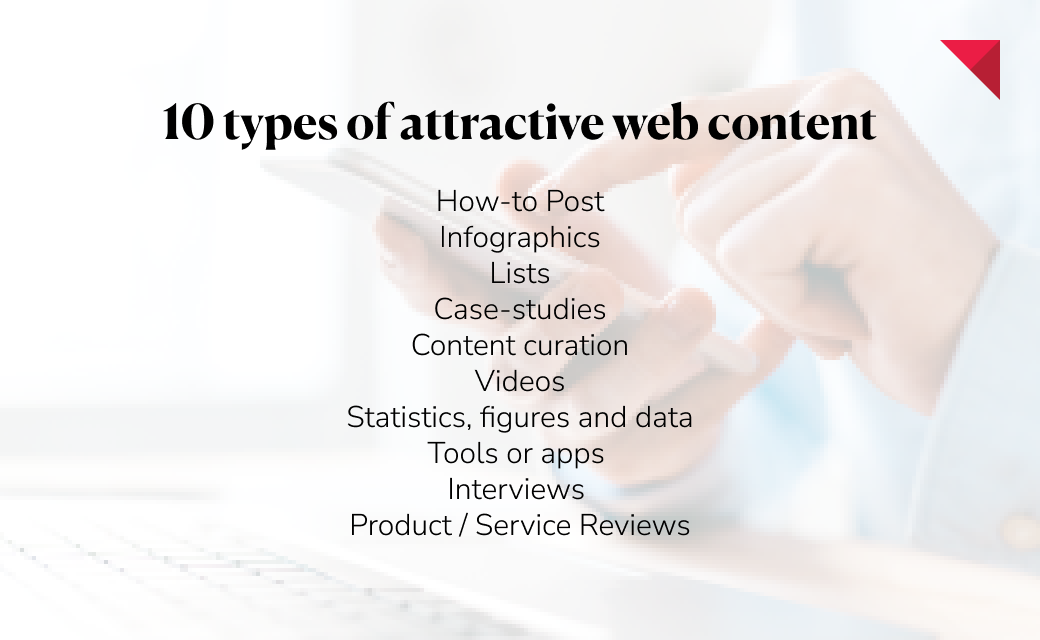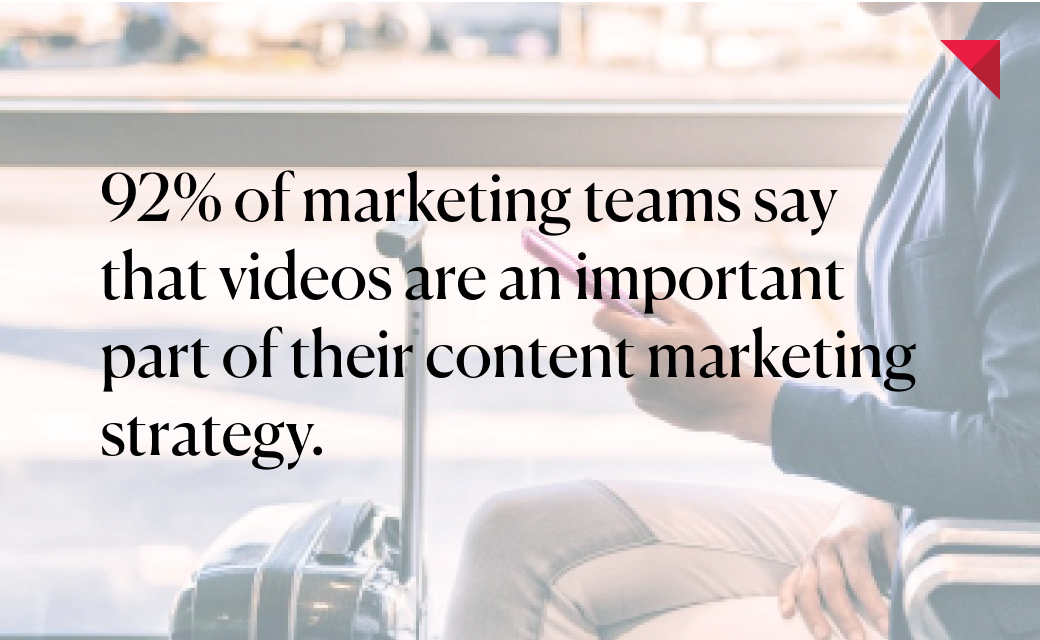Types of web content and social media to increase engagement
Today, content strategy has become one of the key factors when it comes to brand positioning. We’re not just talking about web content, but also social networks that help to spread brand messages, connect with your target audience, and the most important: communicate in the most strategic way for the brand.
In this context, different kinds of contents and formats come into play which offer us a wide range of options, depending on what we want to transmit to our audience. The most important part is picking the option that best meets the specific needs of this moment, network, and type of information. Keep reading to discover more about the content that will help you reach your goals:
Types of web content: how to increase the reading time on the webpage
The very title of this section says it all: the objective when we talk about web content is to increase the average time that the user spends on the page, which translates into:
-
Improving the organic positioning: Google values users that spend time on a page
-
Providing value to the reader: the time that a person spends on a web page is a reflection of the content quality and the user’s interest
That’s why we can’t just think about the text; we must include the rest of the elements that go with it and make it more pleasant and visual. Next, we’ll tell you some of the different uses of web content that will help you reach this goal:
10 kinds of key digital content for your website

1. How-to Post:
Content that teaches the readers ‘How to do” is the most popular and the most-shared content on social media. And why are these posts so popular? Mainly because they are didactic; they sum up the information well, and they are quick to read (according to Medium, the reading time of a post shouldn’t be more than 7 minutes). The majority of users search the Internet for a solution to some problem, which is why ‘How to’ articles are so effective: they give solutions.
2. Infographics:
We’ve already said many times that images are more effective than text when it comes to retaining information. That’s why infographics are so popular among internet users. Graphics that sum up information and statistics in a visual way are a very direct way to transmit information. The downside of these infographics is that they require a lot of time to make, in addition to requiring some design knowledge. However, there are online tools like Easel.ly that facilitate this work through downloadable and free templates.
3. Lists:
Articles structured in lists are very attractive for readers because they get right to the point and eliminate unnecessary information. In a concise, clear, and organized manner, lists give all the information related to the topic. A clear example of this kind of post is this very article that gives you 10 kinds of content that people like to share.
4. Case studies:
Case studies are studies about success stories in a certain area that are used to learn how to do things well. Why are they popular? Because they don’t talk about abstract things; they talk about real cases that have happened and have been successful. In addition, B2B marketing professionals consider case studies to be the most effective content marketing technique when it comes to acquiring quality leads.
5. Curated content:
If there’s something readers like, it’s content that goes above and beyond - not just talking about what they already know. In marketing, this is called content curation and consists of collecting information about a specific topic, polishing and updating it with our own point of view, and making it available to internet users. This is what they consider valuable content, as it saves them search time and unnecessary reading, in addition to providing them with additional content.
6. Videos:
Like images and infographics, videos have an unmatched power of attraction compared to other formats. And we’re not just saying it, it’s reflected in the data about video marketing in companies: 92% of marketing teams say that videos are an important part of their content marketing strategy and 74% of users say that seeing a brand video convinced them to buy or download an app or software, according to this Wyzowl study.

7. Statistics, numbers, and data:
Numbers always provide more credibility to content than words. That’s why users prefer posts that include data extracted from reports, studies, or surveys. By basing ourselves on proven research, internet users tend to believe more of what they read. Although it can be a bit tedious to read documents until we find the right statistic, with it, we can achieve the desired differentiation. At the same time, we provide authority to our content.
8. Tools or apps:
Posts that facilitate useful apps or tools for users are very useful as they serve to save search time and simplify the work. For example, a community manager that needs to use attractive images for the social networks they manage would be happy to have a list of tools that can help them in the process.
9. Interviews:
Interviews are unique content, given that we obtain information from them that no one else has. Look for thought leaders in your target market and interview them, which will give you a lot of credibility from your users. In addition, the people interviewed will share the interview with their followers and just like with an influencer, this will drive traffic towards your site and make your piece more popular.
10. Reviews about products or services:
Reviews work really well with some people that are looking for information about a certain product or service. Before actually buying it, they tend to research it, and one of those paths is the internet. Through testing products and writing reviews about it, recommending or not recommending it, the user is creating unique and valuable content, something very valued by users.
Social media and types of content to generate engagement
When talking about social media strategy, content formats are also key when creating the content plan.
The trend we are observing currently is that different social networks have increasingly similar functions and tools between them. Before, the story format was unique to Snapchat, while now Instagram, Facebook, and Whatsapp all offer it. This allows us to play around more on each platform when creating content.
The important part is knowing what social networks to use to focus on the business goals we are trying to achieve with the content, the buyer personas, and the resources we have.
Next, we’ll tell you the most attractive format to increase engagement on social networks:
- Stories: provide fresh and natural content to users. They offer the possibility of getting to know more about brand values (especially when we talk about a personal brand), of which it’s easier to transmit thoughts and reflections about, which increases the feeling of loyalty to the account. They also provide more visibility to posts and links given that, on networks like Instagram, the algorithm sometimes doesn’t show them enough in the feed, which is one of the biggest complaints of the most influential profiles as it lessens the reach of the posts. In addition, it encourages interaction with users through the question and quiz functions.
-
Reels and TikTok: one of the other formats that excel right now are Reels on Instagram and TikTok. It’s a type of content that goes viral easily and shows the more casual side of the users. But, why is it working so well? Because it’s a highly visual, dynamic format with many options when it comes to creating content. In comparison with IGTV, for example, we can say that it receives much higher engagement.
-
Video marketing: we can’t skip all the posts that have videos. It’s one of the best ways to provide value, information, and brand awareness. In addition, this type of content works well on different social media platforms.
-
Surveys: it’s a way to get closer to the users, learn the preferences and points of view on different ideas, and create more interaction with followers. The key is knowing what question to ask according to the social network in which we find ourselves.
-
Memes: Who doesn’t share memes with their friends every once in a while? These kinds of images are the most commented upon and shared on social networks, but they depend heavily on the language of the brand and sector. It’s important to analyze if this type of content matches your brand guidelines.
In conclusion, there are many formats and ways to create content, but the most important is providing value to your buyer personas. When creating a strategy, this is the fundamental point that we must remember. Schedule different posts according to the needs of your Buyer Personas, making them varied, but at the same time, allowing them to achieve different business objectives.
Subscribe to our newsletter and stay up to date with the latest digital trends.
Subscribe to our newsletter and stay up to date with the latest digital trends.
No thanks. My inbox is fine as it is.